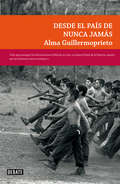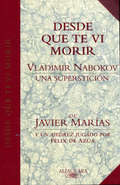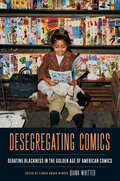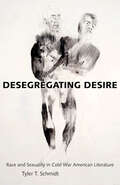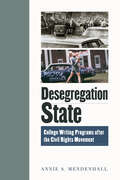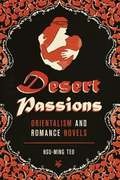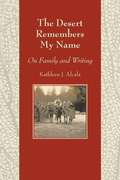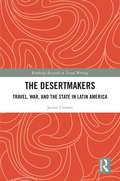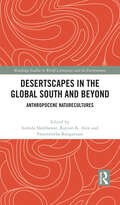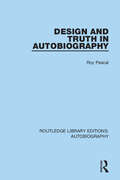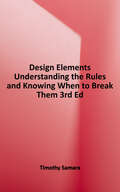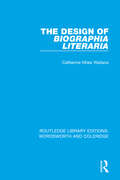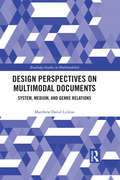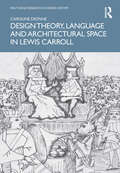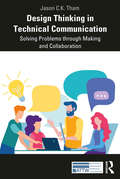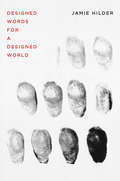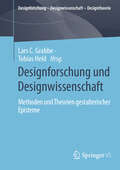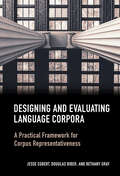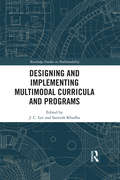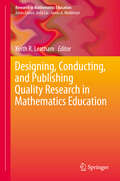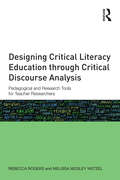- Table View
- List View
Desde el país de nunca jamás
by Alma GuillermoprietoUna magnífica selección de reportajes de Alma Guillermoprieto. Premio Princesa de Asturias de Comunicación y Humanidades 2018 El conflicto civil en El Salvador, la crisis de Granada, la masacre del Mozote, el éxito internacional del grupo adolescente latinoamericano Menudo, la proliferación de sectas y religiones en Río de Janeiro o la lucha entre el gobierno peruano y Sendero Luminoso son solo algunos de los temas que trata Alma Guillermoprieto en sus legendarias crónicas. Publicadas entre 1980 y 2008 en The Washington Post, The New Yorker y The New York Review of Books son pequeñas obras de arte que revelan la cara más humana de algunos de los grandes acontecimientos de los últimos treinta años en América Latina. Reseñas:«Magistral. América Latina ya tiene su Orwell.»David Remnick «Alma Guillermoprieto seenfrenta a la vida con un cuaderno y un bolígrafo en la mano. Es su forma de vida. Es su pasión. Y la disfruta con toda la intensidad posible.»Milenio «Su periodismo temerario, al igual que sus espléndidas descripciones y sus retratos de personajes, son fascinantes.»The Wall Street Journal «Una maravillosa lectura, repleta de humanidad, astucia, curiosidad y conocimiento.»The New York Times Book Review «Guillermoprieto hace una descripción íntima y conmovedora, dura e inteligente de la vida cotidiana durante la revolución.»San Francisco Chronicle, sobre La Habana en un espejo
Desde que te vi morir
by Javier MaríasAl cumplir cien años del nacimiento de Vladimir Nabokov, Javier Marías rinde homenaje al célebre escritor ruso, tal y como hiciera con William Faulkner en Si yo amaneciera otra vez. La traducción de Marías de dieciocho poemas inéditos en castellano; algunos problemas de ajedrez ideados por quien fue gran jugador con sus soluciones; los artículos Fantasmas leídos y El canon Nabokov, la pieza La novela más melancólica (Lolita recontada) y una selecta colección de fotografías conforman este hermoso testimonio.
Desegregating Comics: Debating Blackness in the Golden Age of American Comics
by Qiana WhittedSome comics fans view the industry’s Golden Age (1930s-1950s) as a challenging time when it comes to representations of race, an era when the few Black characters appeared as brutal savages, devious witch doctors, or unintelligible minstrels. Yet the true portrait is more complex and reveals that even as caricatures predominated, some Golden Age comics creators offered more progressive and nuanced depictions of Black people. Desegregating Comics assembles a team of leading scholars to explore how debates about the representation of Blackness shaped both the production and reception of Golden Age comics. Some essays showcase rare titles like Negro Romance and consider the formal innovations introduced by Black comics creators like Matt Baker and Alvin Hollingsworth, while others examine the treatment of race in the work of such canonical cartoonists as George Herriman and Will Eisner. The collection also investigates how Black fans read and loved comics, but implored publishers to stop including hurtful stereotypes. As this book shows, Golden Age comics artists, writers, editors, distributors, and readers engaged in heated negotiations over how Blackness should be portrayed, and the outcomes of those debates continue to shape popular culture today.
Desegregating Desire: Race and Sexuality in Cold War American Literature
by Tyler T. SchmidtA study of race and sexuality and their interdependencies in American literature from 1945 to 1955, Desegregating Desire examines the varied strategies used by eight American poets and novelists to integrate sexuality into their respective depictions of desegregated places and emergent identities in the aftermath of World War II. Focusing on both progressive and conventional forms of cross-race writing and interracial intimacy, the book is organized around four pairs of writers. Chapter one examines reimagined domestic places, and the ambivalent desires that define them, in the southern writing of Elizabeth Bishop and Zora Neale Hurston. The second chapter; focused on poets Gwendolyn Brooks and Edwin Denby, analyzes their representations of the postwar American city, representations which often transpose private desires into a public imaginary. Chapter three explores how insular racial communities in the novels of Ann Petry and William Demby were related to non-normative sexualities emerging in the early Cold War. The final chapter, focused on damaged desires, considers the ways that novelists Jo Sinclair and Carl Offord, relocate the public traumas of desegregation with the private spheres of homes and psyches. Aligning close textual readings with the segregated histories and interracial artistic circles that informed these Cold War writers, this book defines desegregation as both a racial and sexual phenomenon, one both public and private. In analyzing more intimate spaces of desegregation shaped by regional, familial, and psychological upheavals after World War II, Tyler T. Schmidt argues that “queer” desire—understood as same-sex and interracial desire—redirected American writing and helped shape the Cold War era’s integrationist politics.
Desegregation State: College Writing Programs after the Civil Rights Movement
by Annie S. MendenhallThe only book-length study of the ways that postsecondary desegregation litigation and policy affected writing instruction and assessment in US colleges, Desegregation State provides a history of federal enforcement of higher education desegregation and its impact on writing programs from 1970 to 1988. Focusing on the University System of Georgia and two of its public colleges in Savannah, one a historically segregated white college and the other a historically Black college, Annie S. Mendenhall shows how desegregation enforcement promoted and shaped writing programs by presenting literacy remediation and testing as critical to desegregation efforts in southern and border states. Formerly segregated state university systems crafted desegregation plans that gave them more control over policies for admissions, remediation, and retention. These plans created literacy requirements—admissions and graduation tests, remedial classes, and even writing centers and writing across the curriculum programs—that reshaped the landscape of college writing instruction and denied the demands of Black students, civil rights activists, and historically Black colleges and universities for major changes to university systems. This history details the profound influence of desegregation—and resistance to desegregation—on the ways that writing is taught and assessed in colleges today. Desegregation State provides WPAs and writing teachers with a disciplinary history for understanding racism in writing assessment and writing programs. Mendenhall brings emerging scholarship on the racialization of institutions into the field, showing why writing studies must pay more attention to how writing programs have institutionalized racist literacy ideologies through arguments about student placement, individualized writing instruction, and writing assessment.
The Desert Alphabet Book (Jerry Pallotta's Alphabet Books)
by Jerry PallottaThe parched, mysterious deserts of the world are the landscapes for this alphabet array of plants, animals, and phenomena. Meet the colorful Crimson Chat, the deadly Inland Taipan, and the cartwheeling Golden Wheel Spider. Look beneath and beyond the sand for familiar, unfamiliar, and comical desert dwellers.Author Jerry Pallotta and illustrator Mark Astrella invite readers to one of nature's most forbidding environments. And if you feel thirsty after reading about some of the driest places on earth, don't worry. There's a Water-holding frog!
Desert Passions: Orientalism and Romance Novels
by Hsu-Ming TeoThe Sheik-E. M. Hull's best-selling novel that became a wildly popular film starring Rudolph Valentino-kindled "sheik fever" across the Western world in the 1920s. A craze for all things romantically "Oriental" swept through fashion, film, and literature, spawning imitations and parodies without number. While that fervor has largely subsided, tales of passion between Western women and Arab men continue to enthrall readers of today's mass-market romance novels. In this groundbreaking cultural history, Hsu-Ming Teo traces the literary lineage of these desert romances and historical bodice rippers from the twelfth to the twenty-first century and explores the gendered cultural and political purposes that they have served at various historical moments. Drawing on "high" literature, erotica, and popular romance fiction and films, Teo examines the changing meanings of Orientalist tropes such as crusades and conversion, abduction by Barbary pirates, sexual slavery, the fear of renegades, the Oriental despot and his harem, the figure of the powerful Western concubine, and fantasies of escape from the harem. She analyzes the impact of imperialism, decolonization, sexual liberation, feminism, and American involvement in the Middle East on women's Orientalist fiction. Teo suggests that the rise of female-authored romance novels dramatically transformed the nature of Orientalism because it feminized the discourse; made white women central as producers, consumers, and imagined actors; and revised, reversed, or collapsed the binaries inherent in traditional analyses of Orientalism.
The Desert Remembers My Name: On Family and Writing (Camino del Sol)
by Kathleen J. AlcalaAlthough the essays are in many ways personal, they are also universal. When she examines her family history, she is encouraging us to inspect our own families, too. When she investigates a family secret, she is supporting our own search for meaning. And when she writes that being separated from our indigenous culture is “a form of illiteracy,” we know exactly what she means.
The Desertmakers: Travel, War, and the State in Latin America (Routledge Research in Travel Writing)
by Javier UriarteThis book studies how the rhetoric of travel introduces different conceptualizations of space and time in scenarios of war during the last decades of the 19th century, in Argentina, Brazil, Paraguay, and Uruguay. By examining accounts of war and travel in the context of the consolidation of state apparatuses in these countries, Uriarte underlines the essential role that war (in connection to empire and capital) has played in the Latin American process of modernization and state formation. In this book, the analysis of British and Latin American travel narratives proves particularly productive in reading the ways in which national spaces are reconfigured, reimagined, and reappropriated by the state apparatus. War turns out to be a central instrument not just for making possible this logic of appropriation, but also for bringing temporal notions such as modernization and progress to spaces that were described — albeit problematically — as being outside of history. The book argues that wars waged against "deserts" (as Patagonia, the sertão, Paraguay, and the Uruguayan countryside were described and imagined) were in fact means of generating empty spaces, real voids that were the condition for new foundations. The study of travel writing is an essential tool for understanding the transformations of space brought by war, and for analyzing in detail the forms and connotations of movement in connection to violence. Uriarte pays particular attention to the effects that witnessing war had on the traveler’s identity and on the relation that is established with the oikos or point of departure of their own voyage. Written at the intersection of literary analysis, critical geography, political science, and history, this book will be of interest to those studying Latin American literature, Travel Writing, and neocolonialism and Empire writing.
Deserts
by Madeline BoskeyThe fun and excitement of English and Language Arts learning continues in Grade 2 of Reading Street. This comprehensive and dynamic curriculum for homeschooling is geared toward young children who have some foundational English and Language Arts knowledge and are ready to strengthen their skills. Comprised of engaging activities, challenging content and weekly quizzes, Reading Street: Grade 2 is the next step in your child's path toward becoming a lifelong learner and reader. As with all Reading Street products, the Grade 2 system is formatted to help students meet certain age-appropriate goals. After completing this English and Language Arts homeschool program, your child should be able to: Read and comprehend two-syllable words. Identify common prefixes (such as pre-, un-, or re-) and suffixes (such as -able, -ad and -er). Correct mistakes made when reading out loud. Read books with two or more chapters. Understand the structure of stores (i. e. beginning, middle and end). Start selecting reading materials based on his/her own interests. Identify the "who," "what," "when," "where," "why" and "how" of the text. While the goals of second Grade English and Language Arts are numerous, Reading Street will help you craft engrossing lessons. Your child will garner important English and Language Arts skills while completing a workbook, reading stories and poems, and taking assessments. Planning these lessons will be easier than ever, as all Reading Street systems are broken down into weekly Big Ideas. All the work your child does on a given week is formulated around that single concept for an organized and challenging curriculum. With six easy-to-follow units, Reading Street: Grade 2 is the perfect tool for homeschooling parents. Your child will enjoy the reading selections and activities, and you'll love to see your student growing into a knowledgeable individual. We're confident that this product is the right one for you. For more information on the specific materials found in Grade 2 of Reading Street, check out the Features and Benefits page.
Desertscapes in the Global South and Beyond: Anthropocene Naturecultures (Routledge Studies in World Literatures and the Environment)
by Sushila Shekhawat Rayson K Alex Swarnalatha RangarajanEmbracing a rich diversity of voices, this volume seeks to explore the different facets of Anthropocene naturecultures in the desert biomes of the Global South and beyond. Essays in this collection will articulate issues of desertification, indigeneity and re-inhabitation in narratives that thread together Tibet, China, Australia, India, South Mexico, South Africa and Brazil in all their richness and complexity. Re-imaging the desert figure’s rich biodiversity, this book presents new ways to envision the human relationships to natural ecology and mindful accountability, tracing complex narrative connections and challenging hegemonic norms of its role in the co-construction of identity, affect, and gender. Essays also aim to engage in an intertextual conversation with colonial genres that influence the popular conception of these spaces, moving beyond the usual tropes to forge a topographically informed desert identity and posit a ‘natureculture’ ecosystem based on the interpenetration of landscape, culture, and history. This volume includes literary exploration of environmental injustices, analyzing motifs of deforestation, land degradation, falling crop production, toxic man-made chemicals, and extractivist practices linked to various social and economic stressors and gradients in economic and political power. This diverse volume will provide a significant contribution to desert humanities from the Global South, responding to the pressing problems of the Anthropocene and employing place-based ecocritical frameworks that help us imagine a sustainable way of life.
Design and Truth in Autobiography (Routledge Library Editions: Autobiography #7)
by Roy PascalOriginally published in 1960. Is there an art of autobiography? What are its origins and how has it come to acquire the form we know today? For what does the autobiographer seek, and why should it be so popular? This study suggests some of the answers to these questions. It takes the view that autobiography is one of the dominant and characteristic forms of literary self-expression and deserves examination for its own sake. This book outlines a definition of the form and traces its historical origins and development, analyses its ‘truth’ and talks about what sort of self-knowledge it investigates.
Design Elements: Understanding the Rules and Knowing When to Break Them - A Visual Communication Manual
by Timothy SamaraA new and updated 3rd Edition of Rockport's best-selling Design Elements, a visually rich and accessible handbook that presents the fundamentals of design in lists, tips, brief text, and examples. With new images and diagrams, the book covers everything from working with grids, color application, typography, and imagery to how to finally put it all together. <p><p>Features include: <p>•The ultimate primer on graphic design's basic visual toolkit—dot, line, plane, texture, space, and contrast—and how these basics underpin all successful layouts <p>•An in-depth look at color—from its optical qualities and its effect on type to its potential for communication concepts and emotions <p>•One of the most thorough compilations of typography concepts to be found—including information on letterform structure and optics, combining typeface styles, the mechanics of detailed text typesetting, and using type as image <p>•An extensive overview of imagery—the endless possibilities of medium, depiction, abstraction, stylization, and how these all communicate effectively <p>•Methods for integrating type and image, including a tutorial on using grid systems to structure layouts <p>•Twenty rules for making good design—and the best ways to break them <p><p>Being a creative designer is often about coming up with unique design solutions. But when the basic rules of design are ignored in an effort to be distinctive, design becomes useless. In language, a departure from the rules is only appreciated as great literature if recognition of the rules underlies the text. Graphic design is a "visual language," and brilliance is recognized in designers whose work seems to break all the rules, yet communicates its messages clearly.
The Design of Biographia Literaria (RLE: Wordsworth and Coleridge)
by Catherine M. WallaceFirst published in 1983, this book examines a work whose intricacies have baffled and infuriated generations of readers and proposes a theory of Coleridge’s writing habits that "explain(s) his explanation". The author painstakingly analyses the Biographia’s organising structure distinguishing between the daring conception and often inept execution of Coleridge’s idea of critical discourse. It is argued that Coleridge’s autobiographical format present a richly metaphorical "self" whose literary life has led to the now-famous doctrine of secondary imagination. The author’s command of Coleridge scholarship will shed new light on the Biographia for specialists and non-specialists alike.
Design Perspectives on Multimodal Documents: System, Medium, and Genre Relations (Routledge Studies in Multimodality)
by Matthew David LickissThis volume integrates multimodal theoretical frameworks with those from graphic communication and information design and applies this critical synthesis to the examination of the changes and relationships that occur when multimodal documents are distributed across various means and channels of consumption. Drawing on examples from popular newspapers and store catalogs, the book’s specific focus is on documents as sets, here defined as the collective of all the assorted forms of a document published across multiple mediums and modes. This approach affords a multi-layered analysis of multimodal documents more broadly, in addition to engaging in questions about the very definition of a document and the terminology we use in relation to documents, including genres, mediums, and modes. As both a critical examination of the theoretical frameworks employed in literature on documents and a way forward for new approaches to analyzing multimodal texts, this volume is key reading for students and scholars in multimodality, graphic communication, design, media studies, and information science.
Design Theory, Language and Architectural Space in Lewis Carroll (Routledge Research in Design History)
by Caroline DionneThis volume offers spatial theories of the emergent based on a careful close reading of the complete works of nineteenth-century writer and mathematician Lewis Carroll—from his nonsense fiction, to his work on logic and geometry, including his two short pamphlets on architecture. Drawing on selected key moments in our philosophical tradition, including phenomenology and sociospatial theories, Caroline Dionne interrogates the relationship between words and spaces, highlighting the crucial role of language in processes of placemaking. Through an interdisciplinary method that relates literary and language theories to theories of space and placemaking, with emphasis on the social and political experience of architectural spaces, Dionne investigates Carroll’s most famous children’s books, Alice’s Adventures in Wonderland and Through the Looking-Glass and What Alice Found There, in relation to his lesser-known publications on geometry and architecture. The book will be of interest to scholars working in design theory, design history, architecture, and literary theory and criticism.
Design Theory, Language and Architectural Space in Lewis Carroll (Routledge Research in Design History)
by Caroline DionneThis volume offers spatial theories of the emergent based on a careful close reading of the complete works of nineteenth-century writer and mathematician Lewis Carroll—from his nonsense fiction, to his work on logic and geometry, including his two short pamphlets on architecture. Drawing on selected key moments in our philosophical tradition, including phenomenology and sociospatial theories, Caroline Dionne interrogates the relationship between words and spaces, highlighting the crucial role of language in processes of placemaking. Through an interdisciplinary method that relates literary and language theories to theories of space and placemaking, with emphasis on the social and political experience of architectural spaces, Dionne investigates Carroll’s most famous children’s books, Alice’s Adventures in Wonderland and Through the Looking-Glass and What Alice Found There, in relation to his lesser-known publications on geometry and architecture. The book will be of interest to scholars working in design theory, design history, architecture, and literary theory and criticism.
Design Thinking in Technical Communication: Solving Problems through Making and Collaboration (ATTW Series in Technical and Professional Communication)
by Jason ThamThis book explicates the relationships between design thinking, critical making, and socially responsive technical communication. It leverages the recent technology-powered DIY culture called "the Maker Movement" to identify how citizen innovation can inform cutting-edge social innovation that advocates for equitable change and progress on today’s "wicked" problems. After offering a succinct account of the origin and recent history of design thinking, along with its connections to the design paradigm in writing studies, the book analyzes maker culture and its influences on innovation and education through an ethnographic study of three academic makerspaces. It offers opportunities to cultivate a sense of critical changemaking in technical communication students and practitioners, showcasing examples of socially responsive innovation and expert interviews that urge a disciplinary attention to social justice advocacy and an embrace of the design-thinking principle of radical collaboration. The value of design thinking methodologies for teaching and practicing socially responsible technical communication are demonstrated as the author argues for a future in the field that sees its constituents as leaders in radical innovation to solve wicked social problems. This book is essential reading for instructors, students, and practitioners of technical communication, and can be used as a supplemental text for graduate and undergraduate courses in usability and user-centered design and research.
Designed Words for a Designed World: The International Concrete Poetry Movement, 1955-1971
by Jamie HilderSometimes image, sometimes word, and often both or neither, concrete poetry emerged out of an era of groundbreaking social and technological developments. Television, nuclear weapons, radio transistors, space travel, and colour photography all combined to drastically alter the representation of the world in the period following the Second World War. While never fully embraced as poetry or as visual art, and often criticized for an aesthetic that veers too close to commercial design, concrete poetry is an ambitious critical project that strives to break free of national languages and narrow literary traditions. Crossing national and disciplinary borders to highlight connections between poems and a variety of other cultural material, Jamie Hilder shows how the movement's international character predates and initiates some trends now associated with globalization. Hilder places concrete poetry alongside such transformative projects as the modernist city of Brasília, the development of computers, and the rise of conceptual art in order to accentuate its significance as one of the major poetic movements of the twentieth century. Heavily illustrated with examples of poems that exhibit the politically engaged, complex, and varied aspects of the movement, Designed Words for a Designed World illuminates how a group of poets fascinated by the possibilities of a rapidly transforming cultural geography operated within an emerging global imaginary.
Designed Words for a Designed World: The International Concrete Poetry Movement, 1955-1971
by Jamie HilderSometimes image, sometimes word, and often both or neither, concrete poetry emerged out of an era of groundbreaking social and technological developments. Television, nuclear weapons, radio transistors, space travel, and colour photography all combined to drastically alter the representation of the world in the period following the Second World War. While never fully embraced as poetry or as visual art, and often criticized for an aesthetic that veers too close to commercial design, concrete poetry is an ambitious critical project that strives to break free of national languages and narrow literary traditions. Crossing national and disciplinary borders to highlight connections between poems and a variety of other cultural material, Jamie Hilder shows how the movement's international character predates and initiates some trends now associated with globalization. Hilder places concrete poetry alongside such transformative projects as the modernist city of Brasília, the development of computers, and the rise of conceptual art in order to accentuate its significance as one of the major poetic movements of the twentieth century. Heavily illustrated with examples of poems that exhibit the politically engaged, complex, and varied aspects of the movement, Designed Words for a Designed World illuminates how a group of poets fascinated by the possibilities of a rapidly transforming cultural geography operated within an emerging global imaginary.
Designforschung und Designwissenschaft: Methoden und Theorien gestalterischer Episteme (Designforschung – Designwissenschaft - Designtheorie)
by Lars C. Grabbe Tobias HeldVon Gestaltung jenseits ästhetischer Traditionslinien zu sprechen, heißt zwangsläufig das moderne Design in den Blick zu nehmen. Zwischen Alltagskultur und Design-Avantgarden bewegen sich vielfältige interdisziplinäre Strömungen, deren theoretische Modelle in Kontextualisierungen und Analysen der Designwissenschaft zusammenlaufen. Hier zeigt sich bereits eine geisteswissenschaftliche Durchdringung und Akzeptanz des Designs als epidemisches Gegenstück zur freien Kunst, wobei diese Meta-Perspektive letztlich eine Forschung „über Design“ darstellt. Design als konkrete Praxis begriffen artikuliert sich jedoch als Relation von Problem, Entwurf und Prototyp, so dass ein handlungstheoretisches Modell einer Forschung „durch Design“ angesetzt werden kann. Designforschung steht damit im Kontrast zur Designwissenschaft, denn sie agiert dynamisch, empirisch und operativ und bündelt zwar Theoriemodelle und konkrete Werkzeuge, lässt diese aber innerhalb konkreter Gestaltungsweisen zu pragmatischen Erkenntnissen werden. Der Band adressiert konkrete Designfelder, arbeitet Aspekte der konkreten und empirischen Designforschung heraus und nimmt gleichzeitig eine Verortung innerhalb der medientheoretischen Bezugsfelder vor. Denn Forschung „durch Design“ geschieht immer durch Medien, Werke, Instrumente und ästhetische Zeichen und Zustände hindurch.
Designing and Evaluating Language Corpora: A Practical Framework for Corpus Representativeness
by Jesse Egbert Douglas Biber Bethany GrayCorpora are ubiquitous in linguistic research, yet to date, there has been no consensus on how to conceptualize corpus representativeness and collect corpus samples. This pioneering book bridges this gap by introducing a conceptual and methodological framework for corpus design and representativeness. Written by experts in the field, it shows how corpora can be designed and built in a way that is both optimally suited to specific research agendas, and adequately representative of the types of language use in question. It considers questions such as 'what types of texts should be included in the corpus?', and 'how many texts are required?' – highlighting that the degree of representativeness rests on the dual pillars of domain considerations and distribution considerations. The authors introduce, explain, and illustrate all aspects of this corpus representativeness framework in a step-by-step fashion, using examples and activities to help readers develop practical skills in corpus design and evaluation.
Designing and Implementing Multimodal Curricula and Programs (Routledge Studies in Multimodality)
by J. C. Lee Santosh KhadkaThis volume presents a comprehensive overview of multimodal approaches to curriculum and programmatic implementation across a diverse range of teaching environments and across geographic and cultural boundaries. Featuring contributions from scholars within and across both disciplines, the book examines the ways in which new technologies link to expanding definitions of literacy and, building on this, how multimodal approaches might most effectively address the unique opportunities and challenges instructors face in contemporary classrooms and professional development programs. Chapters draw on case studies from both existing scholarship and findings from the authors’ own experiences in practice, including examples from writing, rhetoric, and composition courses, open online learning courses, and interdisciplinary faculty training programs. The final section of the book showcases how the conversation might be further extended to address increasingly multilingual classrooms by exploring how multimodality has been implemented in transnational settings. Engaging with key questions at the intersection of programmatic and curricular development and multimodal studies, this book is a fundamental resource for graduate students and scholars in multimodality, rhetoric studies, language education, applied linguistics, and communication studies.
Designing, Conducting, and Publishing Quality Research in Mathematics Education (Research in Mathematics Education)
by Keith R. LeathamThe purpose of this book is to collect, organize and disseminate collective wisdom with respect to designing, conducting, and publishing quality research in mathematics education. This wisdom will be gleaned from among those who, over the past several decades, have been instrumental in guiding the field in the pursuit of excellence in mathematics education research—insightful editors, educative reviewers, prolific writers, and caring mentors. Each chapter is written to the novice researcher with the intent of aiding them in avoiding common pitfalls, navigating difficult intellectual terrain, and understanding that they are not alone in experiencing rejection, frustration, confusion, and doubt. This book differs from existing literature in the sense that it is written about the enterprise of designing, conducting and publishing research in mathematics education as opposed to being reports of the results of such work. It also differs in the sense that it is written with the intent to mentor the rising generation as opposed to capture the state of the field (as would happen in a handbook, for example). It is written for the express purpose of helping the field work collectively to aid in the often isolated enterprise of mentoring new researchers. The primary audience is a potentially wide one: graduate students, novice researchers, graduate faculty, advisors, and mentors – or anyone seeking to improve their own abilities to design, conduct, and publish quality research in mathematics education.
Designing Critical Literacy Education through Critical Discourse Analysis: Pedagogical and Research Tools for Teacher-Researchers
by Rebecca Rogers Melissa Mosley WetzelUniquely bringing together discourse analysis, critical literacy, and teacher research, this book invites teacher educators, literacy researchers, and discourse analysts to consider how discourse analysis can be used to foster critical literacy education. It is both a guide for conducting critical discourse analysis and a look at how the authors, alongside their teacher education students, used the tools of discourse analysis to inquire into, critique, and design critical literacy practices. Through an intimate look at the workings of a university teacher education course and the discourse analysis tools that teacher-researchers use to understand their classrooms, the book provides examples of both pre-service teachers and teacher educators becoming critically literate. The context-rich examples highlight the ways in which discourse analysis aids teachers’ decision making in the moment and reflections on their practice over time. Readers learn to conduct discourse analysis as they read about critical literacy practices at the university level. Designed to be interactive, each chapter features step-by-step procedures for conducting each kind of discourse analysis (narrative, critically oriented, multimodal), sample analyses, and additional readings and resources. By attending to the micro-interactions as well as processes that unfold across time, the book illustrates the power and potential of discourse analysis as a pedagogical and research tool.
